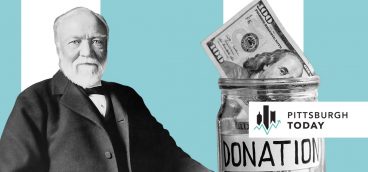Lisa Schroeder, President and CEO of the Pittsburgh Foundation

I was born and raised in Baltimore and lived in Pittsburgh, twice. The first time was in the 1980s, for just a few years. It was a challenging time for the city.
The economic repercussions of the collapse of industry were dominating everything. I returned in 1999, just as a group of 44 extraordinary citizens from government, business and philanthropy gathered to create a vision for local riverfronts and to set a new paradigm for involving the community in the planning process. I was very lucky to move to Pittsburgh at precisely the time that Riverlife was getting started. For me, it would be an unforgettable experience.
At Riverlife, which I joined as deputy director in 2000, task force members spoke out beautifully and persuasively about what they believed was a once-in-a-century opportunity to recast the Pittsburgh riverfronts as an asset and natural treasure rather than the “toxic highway” it had been considered for decades. It was inspiring to see how many people were ready to put their shoulders to the wheel. In the span of two years, a vision was developed that embraced the input of thousands of people, which was then published and codified to make sure that, as we implemented it over the next 15 years, we were expressing the will of the community. We were the keepers of that dream for Pittsburgh, through all levels of implementation—from working on plans in multiple locations with property owners and urban designers to supervising construction, all to encourage the highest level of investment and, above all, public access to the riverfronts.
My interest in efforts such as Riverlife stems from my childhood in Baltimore. I was the oldest of four children. My sister died young, about 15 years ago, from colon cancer. But I still have two brothers (and a brother-in-law, whom I’ve claimed as a sibling), in the Baltimore-Washington, D.C. area. The four of us were born to parents who were dedicated throughout their lives to serving a city that was often in crisis. It was my father’s hometown, and he wrote a book early in his career as a journalist: “The Human Side of Urban Renewal,” which illuminated what were then referred to as “slum conditions” that desperately needed attention through changes in governmental policy and practice. Ultimately, my father became the founding CEO of the first nonprofit development organization in the country, the Charles Center Inner Harbor Development Corporation, a collaboration of government and business that literally created what is now known as Baltimore’s Inner Harbor, from the start of the planning through decades of execution.
The Inner Harbor was the first internationally celebrated model of its kind and started a revolution of revitalization along post-industrial riverfronts in America. Wholly reinvented as a destination for both locals and tourists, the Inner Harbor really started to save the city, which was suffering from the aftermath of the 1968 race riots and alarming disinvestment as businesses fled the city. Simultaneously, my mother, who was from Georgia, started a company, “Downtown Discovery Tours,” to reintroduce people to downtown Baltimore and the charming and quirky historical attractions that there were to see and appreciate. So, I grew up with dinnertime conversation about how to save an American city. I was very fortunate that my parents put a premium on education, and both my undergraduate and graduate school experiences were very formative, focusing on urban redevelopment as a way to improve quality of life.
William Smith College, in Geneva, New York, was a wonderful place for an undergrad and I got to know many interesting people there. After that, I went to live in New York City as a young newlywed and, while pursuing my master’s degree at Columbia, I worked for the City of New York on the Landmarks Preservation Commission, which had the toughest landmarks laws in the country. There, I stumbled into the opportunity to direct The Harlem Research and Survey Project. Our job was to survey every property in Harlem, Riverdale, and the South Bronx, and to conduct research about architectural and cultural distinction. It was the first time that the commission had looked at designating historic property based on factors other than simply architectural distinction. The culture of Harlem, and the Harlem Renaissance, in particular, was fascinating. Our team spent time in the field and also combed archives and libraries in order to make recommendations for designation. Many of the most significant things in Harlem happened in the basements of brownstones, some of which served as jazz venues, or in apartments in fairly nondescript buildings. It was our task to figure out how to recognize such physical places where important historical things had happened.
“Many of the most significant things in Harlem happened in the basements of brownstones, some of which served as jazz venues, or in apartments in fairly nondescript buildings. It was our task to figure out how to recognize such physical places where important historical things had happened.”
—Lisa Schroeder
I was still living in New York during the boom years of the 1980s, and my next job was as a “historic preservation specialist” at the Port Authority of New York and New Jersey, as it planned to renovate the Erie-Lackawanna Ferry terminal, a fantastic Beaux-Arts building with an enormous pressed-copper front on the waterside. The goal was to redevelop that structure into a mixed-use development, including housing for a ferry service to shuttle people back and forth from New Jersey to Manhattan, at a time when downtown Manhattan was very dominant relative to the New Jersey waterfront across the way. We were charged with managing the historic restoration of the terminal building, which was a historic landmark at all levels—local, state and federal. So, we created a sweeping plan that changed over time but, nonetheless, proved that the Port Authority could efficiently run a ferry service—which was its mission—just by having a water station at both ends. It was an amazing opportunity to work for such an enormous public agency in one of the greatest cities in the world.
Donovan Rypkema, a colleague and mentor of mine, is one of the nation’s “gurus” of economic development, particularly through the lens of downtown and urban revitalization. In 1990, he called on me and asked if I’d come aboard at the Real Estate Services Group (now PlaceEconomics) in Washington, D.C. He had been working for the National Trust for Historic Preservation and had been increasingly retained by cities and, ultimately, nations all over the world to do consultation. Donovan hired me to help put together a business model and to expand his business. The job was fast-paced and flexible at a time when I had little children underfoot, of which, ultimately, I had three: one lives in Baltimore, one in Burlington, Vermont, and another in Denver, Colorado. My youngest just graduated from college, and my oldest just got married. And I now have a 2-year old granddaughter, and another on the way.
After my time with Donovan, in 1995, I moved on to become the director of education for Greater Portland Landmarks, Inc., working to preserve and revitalize greater Portland’s historic buildings, neighborhoods, landscapes and parks. At of the best-kept secrets in the country. It was a little-known, small, but thriving city, not just because it was a port, but also because it was, even then, a “foodie capital.” All in all, Maine is a fascinating place because it has such an interesting intellectual and artistic history. It’s a “thinking place.” And I noted, through the years, that an inordinate number of independent politicians came from Maine, which I don’t think was an accident. Maine’s culture is not ideological. It is a straightforward, take-on-the day culture. Mainers are sturdy people who speak no unnecessary words and convene no unnecessary meetings. As quickly as possible, people get to the business at hand, and that stems from the long, independent culture of a place where many people have preferred to run home-owned businesses on their own property. The geography and the weather in Maine carry the day, and it was interesting to live in a place where a heavy fog could grind everything to a halt. But Maine is a staggeringly beautiful place. Even the winters, which are long and dark, often offer clear blue skies, not to mention a multitude of green pines, and lots of white snow.
After my stint in Portland, I spent 15 years at Riverlife in Pittsburgh, only to end up back in Baltimore in 2015 after receiving calls and emails about a job opening at the Parks & People Foundation. Both the founder and president had been at the helm for decades, and the organization was looking for its next chapter, and someone to lead it. By then, my children had all finished college, and we were 80 percent complete at Riverlife in implementing the vision for Three Rivers Park. So, I felt that it was time to move on to my next challenge. So, I headed back to my hometown.
At the time I took the helm, Parks & People had the first new board chairman in its history. And what we found was, as is often common in founder-driven organizations, the foundation needed untangling. So, for several years, it was my job to build new internal financial structures and “right-size” programs. We led a strategic planning process, considered new ways of delivering our projects and programs, and worked with national experts to diversify our funding base because it—and this is also typical of founder-driven organizations—had been driven by the “Rolodex” of the founder. The challenge was to honor the 30-year legacy of accomplishment and goodwill that the organization had built while, at the same time, responding to radically changing circumstances in Baltimore, which was, as always, in crisis.
My first day on the job at Parks & People coincided with the death of Freddie Gray at the hands of local police, and the eruption of nationally publicized, violent protests. The youth rioting actually started on property owned by Parks & People, which gave us a frontline role in the emerging city-wide tumult. That period led us to reinform and recast our organizational mission. We had to reunite the city, so we refocused our efforts in West and East Baltimore neighborhoods, where family incomes are below $25,000 and, shockingly, between 30 and 50 percent of the children live in poverty. We set out to develop programs for children who were being left behind and also to design and build park projects to lift the neighborhoods that had been suffering from chronic disinvestment for generations due to vacancy and abandonment. Through that experience, I had the chance to learn, firsthand, about the struggles caused by the trauma that children in poverty situations face, and the depth of resources needed to assist them.
Over the past 20 years, I’ve seen the needs rise and the pressures build as nonprofits have been called to provide increasing levels of service that, historically, were provided by government. At the same time, nonprofits have faced decreasing and sometimes fractured bases of public support. I know what it’s like to wake up every day with the pressure of fulfilling an important mission, getting the work done, and making sure that we’re raising enough money to support that work. I’m eager to explore new ways in which we can be a model for empowering nonprofits to meet the challenges that they face, because the pressure is still increasing.
This time, I left Baltimore when I really wasn’t planning to do so. I received “the call” from The Pittsburgh Foundation shortly after my father died. (For a number of years, I had been assisting my parents in their last years of life.) Once I learned where the foundation was with its agenda and what it was seeking in a leader, it was such an inarguable and exciting opportunity that I had to explore it. My daughter, who has a 2-year old and stands to lose a lot of free babysitting, said, “Mom, it’s the hand of your father on your shoulder.”
In their quest for a new leader, the search committee members were very clear that the foundation be committed to diversity, equity and inclusion. In Pittsburgh, right now, as in Baltimore, there is a struggle for equity. It’s the issue of our time, and every American city is wrestling with it in different ways. This is not easy, but it is exciting and it is where our country is headed. The effort that The Pittsburgh Foundation has been making to reach into all communities to talk and collect data about what is needed is absolutely essential. I will always regard Baltimore and Pittsburgh as “hometowns,” and I think the cities can learn much from each other.
For me, leaving Baltimore behind has been complicated. I fiercely love both Baltimore and Pittsburgh. The cities are very different, but they share the characteristics of very special architecture and geography, and a “buck and a beer” feistiness. Both also have a mix of culture that supports the arts at a high level. I’ve been overwhelmed by the warmth of the outreach from city leadership since I accepted the position of president and CEO at The Pittsburgh Foundation. That warmth has reminded me of what a remarkable community Pittsburgh is and how passionate people are about making their community better. And I appreciate the fact that the city is particularly collaborative between the “three legs of the stool”—government, business and, in Pittsburgh, all importantly, philanthropy.
As a city, Pittsburgh is a marvelous collection of villages and spectacular views, and I was lucky enough to have been a part of implementing an “impossible dream” here through Riverlife. It took steadfast leadership, but we were able to achieve what we did due to incredibly generous assistance from government, business and philanthropy, all together. We defied the odds and, if it had not been for the bold vision that came out of the community, it would have been difficult to hold the pieces together. Now, it’s fun and gratifying to look out and see thousands of people outside and enjoying the riverfront. Pittsburgh has reinvented itself again, and that’s amazing because it doesn’t happen everywhere. It used to be that, when I said I was from Pittsburgh, people struggled desperately for something positive to say. Now, the responses I receive are, universally, “I hear great things about that town.” Pittsburgh is “hot.”




